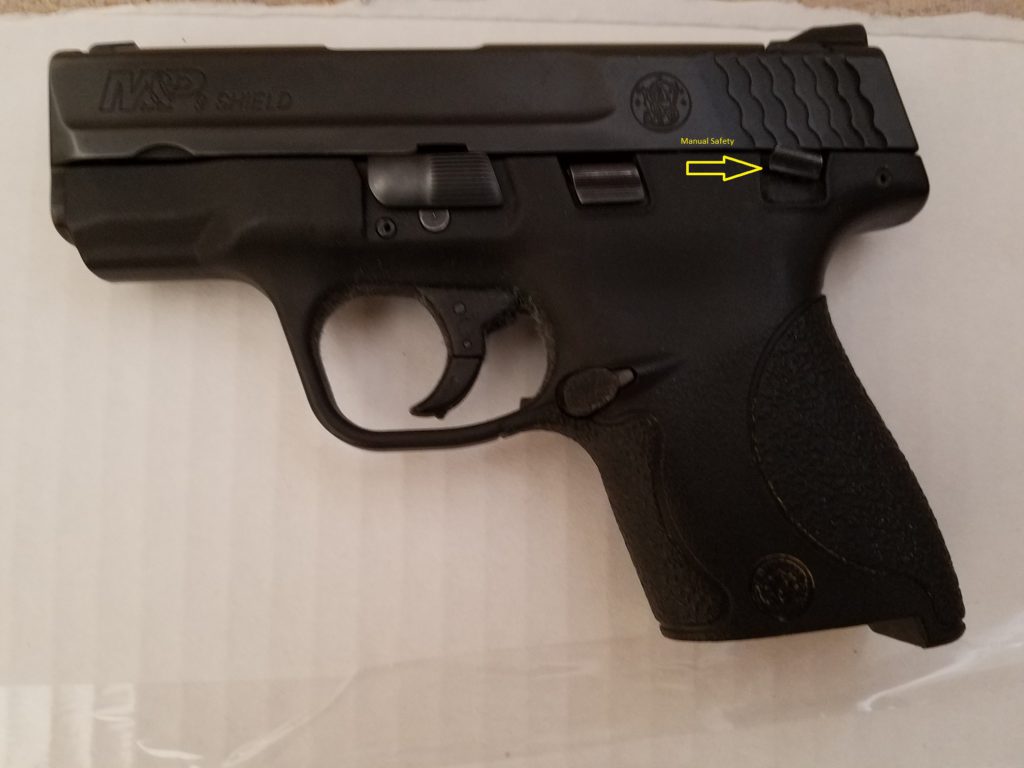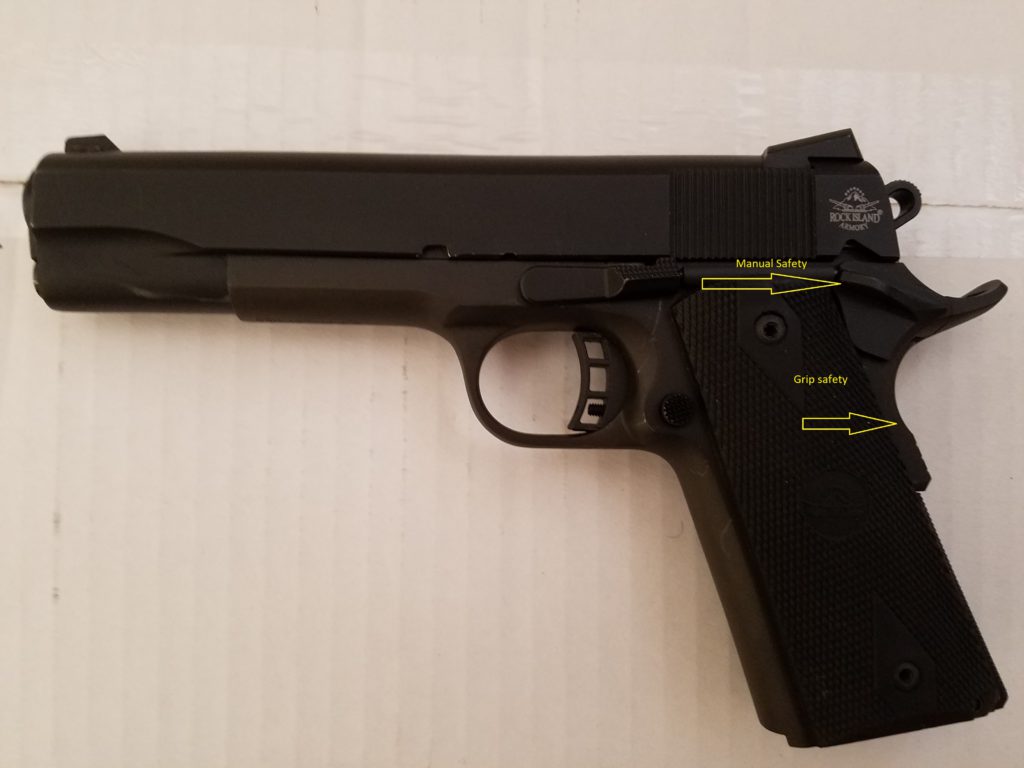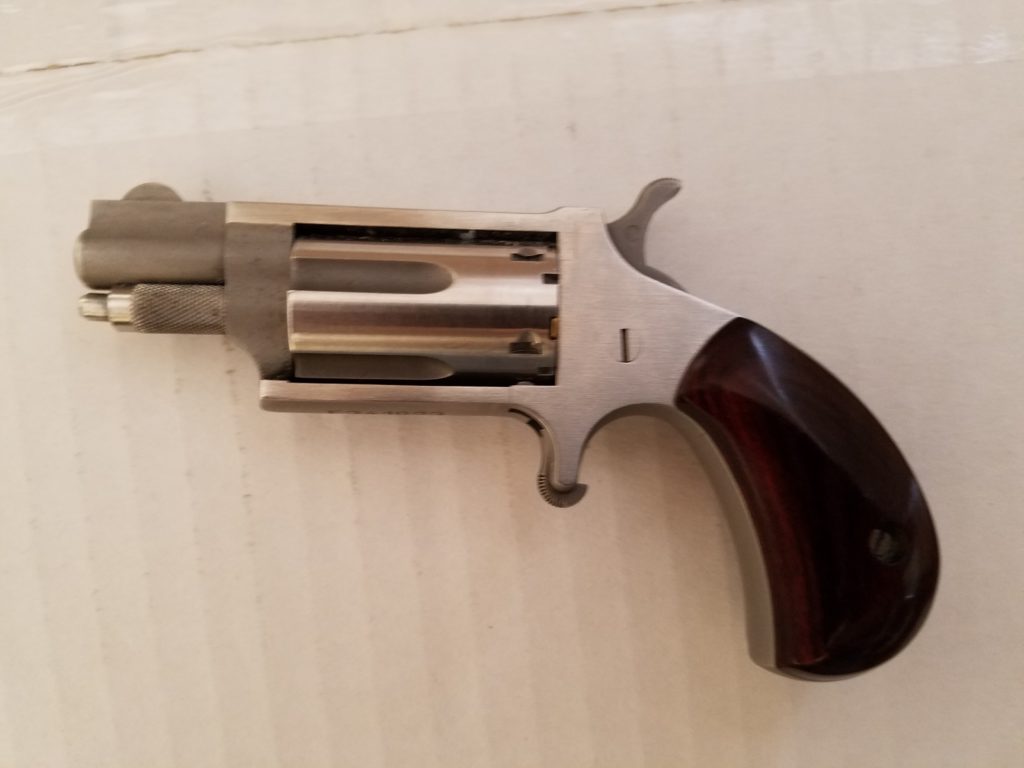There is a lot of debate lately on the usefulness of manual safeties. There is a school of thought that no manual safety is needed. Those who say that have reasons and they’re not too strange (with two exceptions). I just can’t agree with that blanket proscription. Like everything else in the gun world, it comes down to our particular situation.
Table of Contents
What I mean by a safety.
I’m referring specifically to safeties that we have some control over, not the internal types that, for example, keep the gun from firing when dropped.
A safety is a mechanical device – separate from the trigger – that must be activated or switched in order to allow the weapon to fire. Separate from the trigger is the operative concept. In other words, it’s not a blade in the middle of the trigger, a hinged trigger, or any other form of two-part trigger.

- Manual lever – See that little gadget under the serrations on the back of the slide of my Shield? That’s a safety. The gun will not fire in its current state. I have to push that lever down for it to shoot.
- Grip safety – This is a passive device. If you’re pressing that switch the gun will fire. If not, it won’t. A firing grip will press it. My XDm has one of those.
- Magazine disconnect – it will prevent the gun from firing if there’s no magazine in the weapon. Drop the magazine and you’ve rendered the weapon inoperable.

My 1911 has both grip and manual safeties. It has some other fundamental differences with the other two guns. That brings us to…
What kind of gun is it?
A 1911 is a single action gun with a short, light trigger pull. Mine is 3 lbs, 4 oz. In other words, little pressure is required to accidentally pull the trigger. That’s great for accuracy but there’s not the smallest chance I’d carry it without the manual safety. And I do carry it sometimes.
Both the Shield and the XDm, on the other hand, are more modern designs. Both striker fired, not hammer. I’m not getting into the striker/hammer debate here; both methods will ignite the primer of the cartridge and cause the bullet to leave the barrel at the appropriate velocity and that’s the critical thing.
Both of them also have harder trigger pulls than the 1911. My Shield is 5 lbs, 12 oz. The XDm is right at 5 lbs. Both have a significantly longer travel than the single action gun; it takes more effort to fire them.
Revolvers don’t have safeties.
What they have is long, hard trigger pulls. It is much harder to accidentally fire one of them.
Well. Unless they’re single action, in which case you have to cock the hammer before every shot. While not technically a “safety” it’s close enough for government work.

Noticing a trend here?
To sum it up, the harder a gun is to fire the safer it is. Yes, that is counter-intuitive. It’s also true. The more effort required to shoot the gun the less likely you’re going to do so accidentally.
But what if you need the gun to defend yourself?
We’re going to be under stress like most of us have never really experienced. Isn’t it possible you could forget to flip off the safety switch? Or maybe you won’t get a good firing grip?
Yes. It’s possible. And this is the only valid argument against a manual safety. Anything that adds to the complexity has a chance of biting us in the ass. We prepare, train, and practice for something that is very unlikely. That’s what makes us different from most of our fellow citizens. That doesn’t mean we should ignore likelihoods. In the next 10 years I’m not likely to need to pull my gun in self-defense. I’m going to be handling it, practicing with it, holstering it and cleaning it several thousand times in that period. While training for the unlikely is important, shouldn’t we also consider the likely?
And the solution to this problem is training. If your gun has a safety then every time you practice your draw you must practice taking the safety off. The good news is that you don’t need to fire to ingrain this habit. Dry fire will be fine. If you happen to have a firearm that shouldn’t be dry fired, there are these.
What if it’s not us with our gun?
When police departments were moving from revolvers to autoloaders, alongside the arguments of capacity and easy reloads was this: if a criminal takes an officer’s gun he can’t just point and shoot. He has to be aware of how the gun functions to make it work. It’s not rocket science and most can figure it out but it takes time. And maybe that time is enough for the officer to get his gun back, move to cover, or pull his backup.
That was a valid argument then and it’s a valid argument now. Lives have been saved this way. The article isn’t specifically about safeties but the 7th paragraph (“In the late 1970s…”) is relevant to our current topic.
As concealed carriers we’re less likely to become targets of a gun grab. If our attacker is close, though, it’s still possible.
Our gun should always be under our control or in a safe location where unauthorized people can’t get to it. It just doesn’t always happen that way. People who should not have them get hold of guns all the time. I’m not referring to criminals; I’m talking about kids or curious, clueless adults who see the shiny, cool gun and want to touch it.
Two dumb arguments against a safety.
1. The gun won’t fire unless you pull the trigger. Tell that to this guy. The gun will fire when the trigger is pulled. Whether that’s you, a part of your holster, your shirt tail, or the drawstring of your hoodie means nothing to the gun. Trigger goes back; bullet comes out.
2. A safety is a mechanical device that can fail. You know what else is a mechanical device that can fail? Your brain. And your brain fails you every single day.
- Where are my glasses (keys, etc.)?
- Why did I come into this room again?
- Hey, can you call my phone?
Now which of those, brain or switch, is more reliable?
“The best safety is between your ears.”
That is correct. That is absolutely the best safety. Who says it has to be the only one? See above. Our brains need help all the time. Why should this be any different? If we count on being perfect we are setting ourselves up for failure.
Does a safety make the gun safe?
Absolutely not. It makes it safer. That is not the same as perfectly safe because a perfectly safe gun is impossible. It’s not supposed to be safe. What we’re trying to do is tilt the odds in our favor so that we decide when it’s dangerous and to whom.
There are other ways to solve every single problem that a safety solves. And as soon as human beings are perfect and never get distracted or forget things then the safety can, will, and should go the way of the dodo. Until then, it’s a useful thing.
It’s your call. Your life, your gun, your decision. Only you can decide whether you should have and use a mechanical safety or not.
For the record, here are my choices:
- Shield (my primary carry gun) – safety on.
- 1911 – safety on.
- Pico – has no safety.
- NAA revolver – single action revolver requiring hammer cock to fire.
- XDm – grip safety.